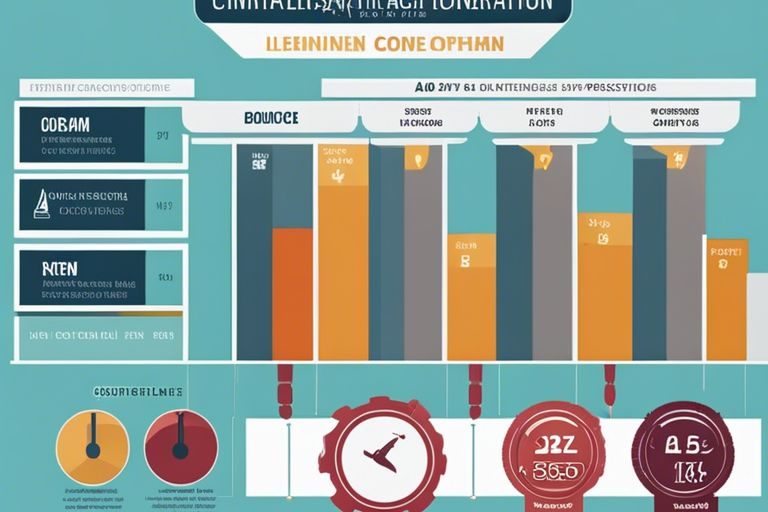Understanding Licensing and Regulation

#Licensing and #regulation are terms that are often used interchangeably in various industries, causing confusion among both professionals and consumers alike. However, it is crucial to understand the distinct differences between the two in order to navigate the complex world of compliance effectively. Licensing refers to the process by which an individual or #business obtains permission to engage in a particular activity, while regulation involves the rules and standards set forth by governing bodies to ensure compliance and uphold safety.
Defining Licensing and Regulation
What is Licensing?
Defining licensing is crucial in understanding the nuances of this aspect of oversight. Licensing refers to the process through which an individual or entity obtains permission from a governing body to engage in a specific activity. This could include professions like doctors, lawyers, or contractors, as well as businesses such as restaurants or retail outlets. Licenses are typically granted after an applicant has met certain requirements, which could include education, training, examinations, and background checks.
What is Regulation?
Defining regulation is necessary in unpacking its importance and impact on various sectors. Regulation involves the establishment and enforcement of rules by a government body to control or supervise certain activities or industries. These rules are put in place to ensure compliance with standards, protect the public interest, and maintain order in the market. Regulation can cover a wide range of areas including safety, security, environmental protection, and consumer rights.
Regulation is necessary in safeguarding consumers, preventing monopolies, and promoting fair competition. It provides a framework for businesses to operate within ethical boundaries and helps maintain integrity in various sectors. While some may view regulation as stifling innovation or imposing unnecessary restrictions, its role in fostering a level playing field and upholding public welfare cannot be undermined.
The Foundations of Licensing and Regulation
Historical Context
There’s a long history behind the concepts of licensing and regulation. These practices date back centuries, originating as a means to maintain quality standards and protect the public interest. In the ancient world, guilds and trade associations imposed licensing requirements to ensure that only skilled and qualified individuals could practice certain trades or professions.
Legal Framework
Foundations of modern licensing and regulation can be traced back to the Industrial Revolution when urbanization and industrialization led to the need for government intervention to address public health and safety concerns. Today, licensing and regulation are widely used across various industries to establish standards, oversee practices, and protect consumers. Another crucial aspect of the legal framework is the enforcement mechanisms put in place to ensure compliance with established rules and regulations.
Purpose and Benefits of Licensing
Despite certain misconceptions, licensing serves a crucial purpose in various industries by regulating professionals’ qualifications and ensuring compliance with standards. This system plays a vital role in protecting public safety, promoting consumer trust, and maintaining industry integrity.
Protecting Public Safety and Welfare
Welfare of the public is a primary concern addressed by licensing requirements. By mandating that individuals meet specific education, training, and ethical standards before practicing in a given field, licensing safeguards society from potential harm and exploitation. For instance, licenses for healthcare professionals, architects, and engineers help ensure that practitioners have the necessary skills and knowledge to deliver services safely and effectively.
Establishing Professional Standards
Any profession that requires specialized knowledge or skills benefits from licensing, as it establishes a baseline for competency and professionalism. Setting minimum standards for education, training, and experience helps maintain consistency in service quality and fosters credibility within the industry. This oversight enhances consumer confidence and protects the reputation of the profession.
It’s necessary to note that licensing requirements can vary widely across different professions and jurisdictions. Some licensing boards may have more stringent criteria than others, reflecting the complexity and potential risks associated with certain fields. However, the overarching goal remains consistent: to promote excellence and accountability in professional practice.
Economic Considerations
An often overlooked aspect of licensing is its impact on the economy. Licensing can create barriers to entry into certain professions, limiting competition and potentially leading to higher prices for services. However, proponents argue that these restrictions can also enhance market stability by ensuring that only qualified professionals are allowed to practice, reducing the risk of substandard work that could harm consumers or undermine industry reputation.
Benefits of licensing extend beyond individual professionals to encompass broader societal interests, such as public health, safety, and trust. While critics may point to certain drawbacks of licensing systems, it is clear that the overall benefits of upholding professional standards and protecting public welfare far outweigh the potential drawbacks. Properly implemented licensing frameworks contribute to a more secure and reliable environment for both professionals and consumers alike.
The Role and Impacts of Regulation
Ensuring Compliance and Enforcement
All industries, from healthcare to finance, are subject to regulations to ensure compliance with standards and laws set by governing bodies. Regulations establish the necessary framework for businesses to operate within legal boundaries. For businesses, compliance means meeting the requirements set forth by regulatory bodies, which can include anything from licensing to reporting standards. Enforcement of regulations is imperative to maintain the integrity of the market and protect consumers from unethical practices.
Prevention of Market Failures
Preventing market failures is a core objective of regulatory bodies. These failures can arise from factors such as monopolies, externalities, or information asymmetry, leading to inefficiencies in the market. Prevention of such failures involves implementing regulations that promote competition, transparency, and fair practices. By doing so, regulators can help ensure that markets function effectively and efficiently for the benefit of both businesses and consumers.
Another critical aspect of preventing market failures is addressing systemic risks within industries. Regulatory bodies work to identify and mitigate risks that could potentially destabilize entire sectors, such as the financial industry. By establishing regulations that monitor and control these risks, regulators can safeguard the stability of markets and protect against catastrophic events that could have far-reaching consequences.
Consumer Protection and Confidence
Consumer protection is a central focus of regulatory efforts, aimed at safeguarding the rights and interests of individuals in the marketplace. Enforcement of consumer protection regulations ensures that businesses act ethically and responsibly towards their customers, providing them with accurate information, fair pricing, and recourse in case of disputes. By instilling confidence in consumers, regulations help build trust in the market and foster long-term relationships between businesses and their clientele.
It is crucial for regulatory bodies to continually adapt and evolve their strategies to address emerging issues and challenges in the market. By staying proactive and responsive, regulators can effectively protect consumers, promote fair competition, and uphold the integrity of industries. Strong regulatory frameworks are imperative for maintaining a healthy and sustainable marketplace for all stakeholders involved.
Comparing and Contrasting Licensing and Regulation
Unlike what many people may think, licensing and regulation are not the same thing. While they both aim to ensure public safety and well-being, they approach the goal in different ways. Licensing is a process by which individuals or businesses obtain permission to engage in a certain activity, such as practicing a profession or operating a business. Regulation, on the other hand, refers to the rules and standards set by a governing body to oversee and control the conduct of individuals and businesses in a particular industry.
| Licensing | Regulation |
| Licensing grants permission to individuals or businesses to engage in specific activities. | Regulation sets rules and standards to oversee and control conduct in a particular industry. |
| Licensing focuses on qualifications and requirements for individuals or businesses to participate in the activity. | Regulation focuses on monitoring and enforcing compliance with established rules and standards. |
| Licensing is typically a one-time process or requires periodic renewal. | Regulation is an ongoing process of monitoring and enforcing compliance. |
Overlaps and Distinctions
Overlaps in licensing and regulation can create confusion, but it’s vital to understand the distinctions between the two. While licensing sets the initial qualifications for individuals or businesses to enter a specific field, regulation ensures ongoing compliance with standards and rules. For example, a licensed healthcare provider must follow regulations set by governing bodies to maintain the quality of care provided to patients.
Case Scenarios Where Both Apply
Case scenarios where both licensing and regulation apply include industries such as healthcare, finance, and transportation. In these industries, professionals are required to obtain licenses to practice their professions while also adhering to regulatory standards to ensure public safety and well-being. For instance, a taxi driver needs a license to operate a vehicle for hire, and transportation regulations dictate safety measures and conduct standards during service.
Case Scenarios Where Both Apply: In the healthcare industry, doctors, nurses, and other healthcare professionals are required to obtain licenses to practice, demonstrating their qualifications and skills. At the same time, healthcare regulations govern the standards of care, patient confidentiality, and safety protocols to ensure the well-being of patients. Compliance with both licensing requirements and regulatory standards is critical in maintaining the quality and integrity of healthcare services.
Implementation Challenges in Licensing and Regulation
Now, when it comes to implementing licensing and regulation frameworks, various challenges arise. These obstacles can hinder the efficiency and effectiveness of these systems, impacting their ability to achieve their intended goals. In this chapter, we will probe deeper into some of the most prominent challenges faced in the implementation of licensing and regulation.
Administrative and Bureaucratic Hurdles
Bureaucratic hurdles often plague the implementation of licensing and regulation efforts. The complex administrative processes, extensive paperwork, and red tape can slow down the entire regulatory process, leading to delays in the issuance of licenses and enforcement of regulations. In many cases, the bureaucratic hurdles can become overwhelming, causing frustration for both regulators and applicants. Streamlining bureaucratic processes and reducing unnecessary paperwork is crucial to improving the efficiency of licensing and regulation systems.
Balancing Efficiency and Rigor
Balancing efficiency and rigor is a delicate task for regulatory bodies. While it is vital to ensure that regulations are robust and comprehensive, excessively stringent requirements can impede the smooth operation of businesses and industries. Finding the right balance between efficiency and rigor is crucial to maintaining a regulatory framework that is both effective and conducive to economic growth. Regulators must continuously assess and refine their processes to strike this balance effectively.
To maintain a balance between efficiency and rigor, regulators can consider implementing risk-based approaches that focus resources on high-risk areas while applying a lighter touch to lower-risk activities. This targeted approach can help optimize regulatory outcomes without stifling innovation and economic development.
Adapting to Technological Changes and New Industries
Balancing the need for regulations that keep pace with technological advancements and emerging industries is another significant challenge. New technologies and industries often outpace existing regulatory frameworks, creating gaps that can be exploited by bad actors. Regulators must proactively monitor developments in technology and industry trends to adapt regulations accordingly. Failure to do so can result in ineffective or outdated regulations that fail to address new risks adequately.
Administrative bodies need to be agile and responsive to changes in technology and industry landscapes. Collaboration with industry stakeholders, experts, and other regulatory agencies can help foster a more dynamic regulatory environment that can quickly respond to new challenges and opportunities.
Best Practices and Recommendations
Streamlining Processes for Stakeholders
Many times, the processes surrounding licensing and regulation can be convoluted and time-consuming for stakeholders. To improve efficiency and effectiveness, it is crucial to streamline these processes. This can be achieved by implementing online application systems, clear guidelines, and regular communication with stakeholders. By providing resources and support, the workflows can be optimized, ensuring a smoother experience for all involved parties.
Harmonizing Licensing and Regulation
Many challenges arise when licensing requirements do not align with regulatory standards. On one hand, licensing ensures professionals meet specific qualifications, while regulation ensures compliance with set standards. Harmonizing these two aspects is necessary to create a coherent framework that fosters accountability and professionalism in the industry.
By aligning licensing requirements with regulatory standards, a more consistent and transparent system can be established. This alignment not only benefits stakeholders by reducing confusion but also enhances overall public trust and confidence in the industry.
Recommendations
Fostering Innovation While Maintaining Oversight
Harmonizing innovation with oversight is a delicate balancing act. It is crucial to encourage creativity and advancement while ensuring that regulatory standards are met. This can be achieved by promoting a culture of compliance and providing guidance on how to innovate within the established framework.
Fostering a supportive environment for innovation while maintaining oversight safeguards against potential risks and promotes responsible growth within the industry. By finding the right balance, stakeholders can benefit from advancements while upholding the necessary regulations that protect consumers and maintain integrity.
To wrap up
From above, it is evident that there is a significant difference between licensing and regulation. Licensing involves granting permission to individuals or organizations to carry out certain activities, whereas regulation involves setting and enforcing rules and standards to ensure compliance within a particular industry. While both serve to maintain order and protect the public interest, understanding the distinctions between the two is crucial in navigating the complex landscape of legal requirements.
Business owners and individuals alike should be aware of the implications of licensing and regulation, as non-compliance can lead to severe consequences. By seeking proper guidance and staying informed on the specific requirements for their industry, stakeholders can confidently operate within the boundaries set by law. Clarifying the confusion between licensing and regulation is important for fostering a transparent and compliant business environment that safeguards the interests of all parties involved.
FAQs
What is the primary difference between licensing and regulation?
Licensing grants permission to individuals or businesses to engage in specific activities, while regulation sets and enforces rules to oversee and control conduct within an industry.
Why is licensing important for public safety?
Licensing ensures that individuals meet specific education, training, and ethical standards before practicing, safeguarding society from potential harm and exploitation.
How do regulations benefit consumers?
Regulations protect consumers by ensuring businesses act ethically, provide accurate information, fair pricing, and recourse in case of disputes, thereby building trust in the market.
What challenges do regulators face in implementing licensing and regulation?
Regulators face challenges such as bureaucratic hurdles, balancing efficiency and rigor, and adapting to technological changes and new industries.
How can the processes of licensing and regulation be improved?
Streamlining processes through online systems, clear guidelines, and regular communication can improve efficiency, while harmonizing licensing requirements with regulatory standards ensures consistency and transparency.
Recommended Posts

MasterCard Payment Solutions for Online Casino Fans
July 1, 2024

Comparing Payment Methods – Pros and Cons
July 1, 2024

Denmark Gambling Regulations 2025
July 1, 2024




